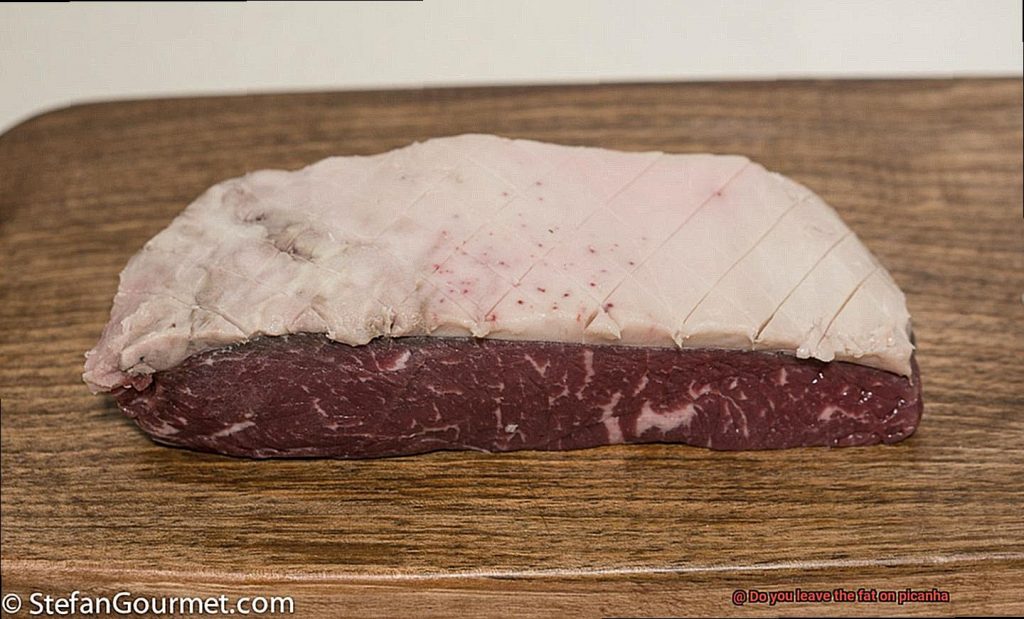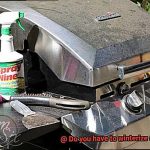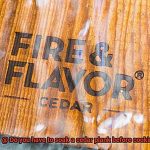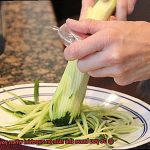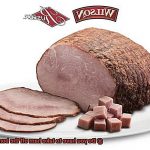Do you love indulging in a juicy, tender, and bold-flavored cut of beef? If so, then you’re probably familiar with picanha – the popular Brazilian meat that’s a favorite among carnivores. But what about the thick layer of fat that comes with it? Should you trim it off or leave it on for cooking and serving?
The debate is ongoing: some swear by leaving the fat on to enhance the flavor and succulence of the meat, while others argue that trimming off excess fat is necessary for a healthier meal. So which approach should you take when it comes to picanha?
In this blog post, we’ll dive deeper into this topic and explore the benefits and drawbacks of leaving the fat on picanha. We’ll also discuss different cooking methods with and without the fat, how they impact texture and taste, as well as health considerations such as nutritional value.
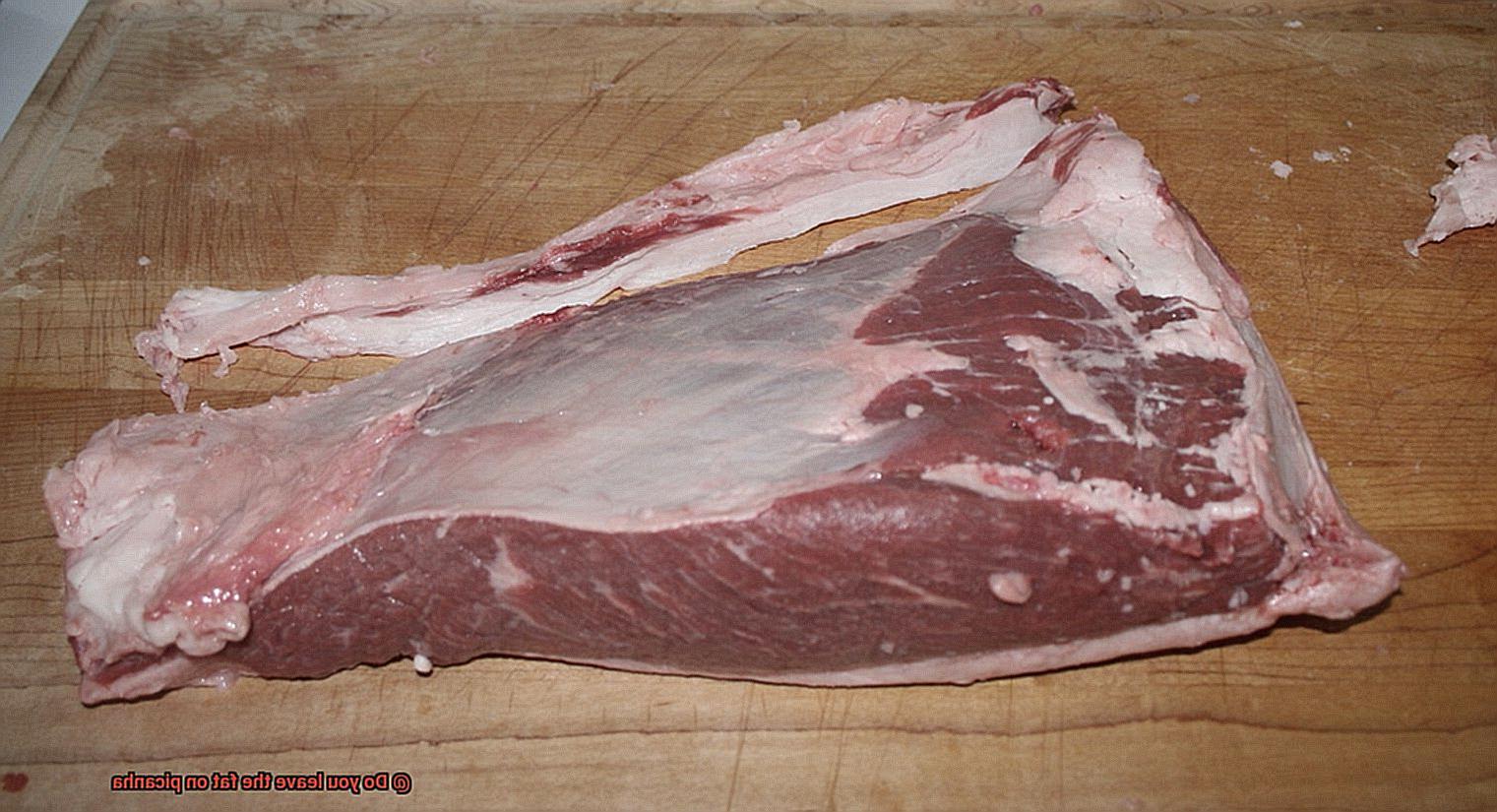
If you’re a meat lover grappling with this dilemma, don’t worry – we’ve got you covered. By the end of this post, you’ll know all there is to know about cooking and enjoying picanha – whether you choose to keep or remove the fat. So sit back, relax, and let’s get started.
Contents
What is Picanha?
Picanha is a mouth-watering cut of beef that has gained popularity in Brazilian cuisine and is quickly becoming a favorite in other parts of the world. Also known as the top sirloin cap, rump cap, or coulotte, this cut is shaped like a triangular spur, hence its name “picanha” derived from the Portuguese word “picana.”
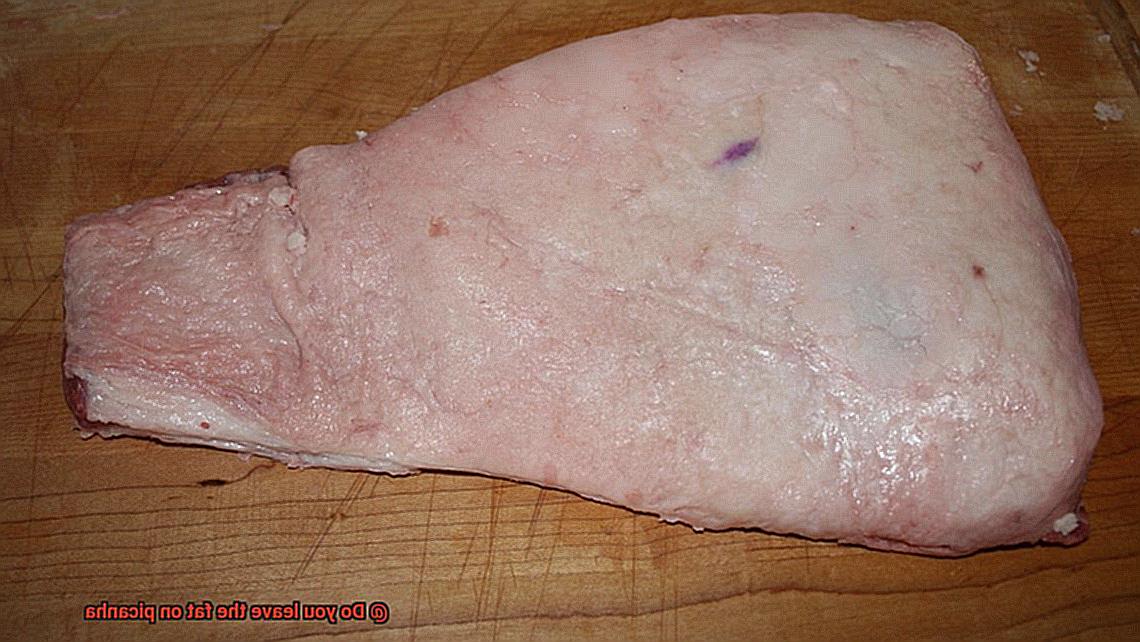
One of the distinguishing features of picanha is its thick layer of fat on top. While some may find this intimidating, it’s actually one of the reasons why picanha is so flavorful and tender when cooked correctly. The fat layer adds to the succulence and taste of the meat.
There’s some debate over whether to leave the fat on or remove it before cooking. If you decide to keep it, scoring the fat with shallow cuts in a crosshatch pattern helps render it down and become crispy during cooking. On the other hand, if you prefer to trim it, leaving a thin layer intact will still enhance the flavor and juiciness of the meat.
Picanha is traditionally seasoned with coarse salt and grilled over charcoal until medium-rare or medium. When cooked to perfection, it’s a culinary delight that’s often served with chimichurri sauce or other condiments that complement its taste.
This cut of beef is a staple at churrascarias (Brazilian steakhouses) and served on skewers alongside other cuts of meat. Its rich flavor and unique shape make it an unforgettable addition to any meal.
How to Identify the Cut of Beef?
For meat lovers seeking a new and flavorful cut of beef, look no further than the picanha. Hailing from Brazil, this delicious cut is characterized by its thick layer of fat on one side, which adds to its rich flavor. Here’s how to identify this mouth-watering cut of beef.
Look for the Triangular Shape
One easy way to spot picanha is by its unique triangular shape. The cut tapers off into a point on one end and widens on the other, where the fat cap is located. This distinctive shape sets it apart from other cuts of beef.
Check the Texture
Another way to identify picanha is by its coarse texture, which sets it apart from other cuts of beef. The muscle fibers are visible, making it easier to spot in the meat aisle or at your local butcher.
Ask Your Butcher for Assistance
If you’re unsure about which cut of beef is picanha, don’t hesitate to ask your local butcher for help. They should be able to point it out and give you tips on how to cook it perfectly.
Read the Label Carefully
If you’re purchasing pre-packaged beef at the grocery store, check the label carefully for the terms “picanha” or “top sirloin cap.” This way, you can be sure that you’re getting the right cut of beef.
Look for the Fat Cap
Picanha is often sold with a thick layer of fat on one side, which adds to its juicy and flavorful taste when cooked. If you see a cut of beef with a fat cap in this area, it’s likely picanha.
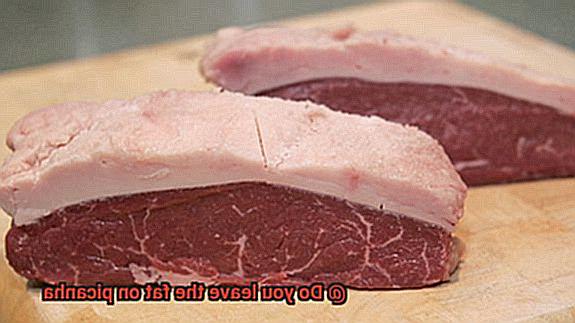
Should You Leave the Fat On or Off?
On the one hand, those who leave the fat on argue that it enhances the flavor and texture of the meat. Meanwhile, those who remove the fat prefer a healthier meal.
If you are a fan of leaving the fat on, you’ll be pleased to know that it can add incredible flavor and texture to your picanha. When cooked correctly, it renders down into crispy, succulent goodness that can elevate your dish to new heights. Additionally, it helps keep your meat moist and juicy, preventing it from drying out during cooking.
However, if you’re trying to watch your calorie and fat intake, then removing excess fat is a healthier option. Picanha is already considered a relatively fatty cut of beef, so by taking off some of the fat, you’re reducing overall calorie and fat intake. Some also argue that removing the fat allows for a more pure beef flavor.
Ultimately, the decision to leave the fat on or off comes down to personal preference. If you prioritize flavor and juiciness above all else, leaving the fat on might be the way to go. But if you’re more health-conscious or prefer a more pure beef flavor, taking off the excess fat may be a better choice.
No matter which option you choose, it’s essential to remember that proper cooking techniques are vital for a safe and delicious meal. Make sure that your picanha is cooked to an internal temperature of at least 145°F for food safety reasons.
Pros and Cons of Leaving the Fat On
This age-old question has left carnivores divided for years, but there are pros and cons to both options, and ultimately, the decision will come down to personal preference.
One of the main arguments for leaving the fat on is that it enhances the flavor and moisture of the meat. The fat helps to baste the meat as it cooks, creating a juicy and tender texture that’s hard to beat. It also provides a rich, beefy flavor that many people find absolutely delicious – a true treat for the taste buds.
In addition to taste, leaving the fat on can help protect the meat from overcooking. The fat acts as a barrier between the heat and the meat, preventing it from drying out or becoming tough during cooking. This benefit ensures that you get a perfect cut of meat every time.
However, there are some downsides to leaving the fat on. For one, it can be difficult to cook evenly. The fat may render at different rates than the meat itself, leading to uneven cooking or charring in some areas. This drawback is something you should consider if you’re looking for a perfectly cooked piece of picanha.
Another factor to take into account is personal preference – some people simply don’t enjoy eating fat and may find it unappetizing. Others may be watching their fat intake for health reasons and prefer to trim off as much as possible.
Ultimately, whether to leave the fat on or not is entirely up to you. Some people swear by leaving it on for maximum flavor and tenderness, while others prefer a leaner cut of meat. It’s important to experiment and find what works best for your taste buds.
Pros and Cons of Removing the Fat
Removing the fat or leaving it on has its own set of pros and cons, and it’s essential to weigh them carefully before making a decision.
PROS:
- Even cooking – Removing the fat from picanha can make it easier to control the temperature of the meat, resulting in more even cooking. Fat takes longer to cook than meat, making it difficult to achieve uniform results when left on.
- Health – Picanha is already a fatty cut of beef, and removing some of the excess fat may be beneficial for those who are watching their fat intake.
CONS:
- Flavor and moisture – Leaving the fat on can add flavor and moisture to picanha as it melts during cooking. The fat can baste the meat, keeping it moist and preventing it from drying out.
- Texture – Some people appreciate the flavor and texture of the fat when it’s cooked properly. It’s essential to note that different parts of the world have different cultures regarding the consumption of fats.
It’s important to remember that whether you remove the fat or leave it on is a personal choice. Experimenting with different methods is crucial to finding what works best for your taste buds.
If you decide to remove the fat, be sure to do so before cooking. Use a sharp knife to trim away the excess fat carefully, being cautious not to remove too much and compromising flavor and moisture.
On the other hand, if you prefer to leave the fat on, scoring it before cooking will help it render down more evenly and prevent curling during grilling.
Scoring the Fat for Crispy Results
This simple technique involves making shallow cuts in a diamond pattern on the fat cap, allowing it to render and crisp up during cooking, resulting in a deliciously crispy and flavorful exterior.
To score the fat on picanha, start by placing the meat on a cutting board with the fat cap facing up. Carefully make shallow cuts in a diagonal pattern, about 1/4 inch apart, in one direction. Then repeat the process in the opposite direction, creating a diamond pattern. It’s important to be precise and even with your cuts to ensure consistent cooking.
- But be cautious not to cut too deeply into the meat – the cuts should only be shallow enough to expose some of the fat. By scoring all areas of the fat cap evenly, you’ll prevent the meat from curling up during cooking and ensure a perfectly cooked piece of meat every time.
- Scoring isn’t just about achieving that crispy exterior – it’s also about enhancing the flavor of your picanha. As the fat renders and crisps up, it infuses the meat with its rich flavor, resulting in a mouth-watering experience.
Best Cooking Methods for Picanha
As an expert in cooking methods for picanha, I’m here to guide you through the best techniques that will leave your taste buds singing.
Firstly, let’s talk about the two main cooking methods that can create a delicious picanha. Grilling over high heat is a popular choice as it creates a crispy outer layer while keeping the inside juicy and tender. Alternatively, roasting in the oven can provide a different texture and is a great option if you don’t have access to a grill.
When it comes to the fat on your picanha, there are pros and cons to leaving it on. Some people prefer to trim most of it away before cooking, while others love the added flavor and moisture it provides. If you choose to leave the fat on, make sure to score it with a sharp knife before cooking. This helps it render evenly and prevents it from curling up as it cooks.
It’s also essential to monitor your meat carefully as it cooks, adjusting the heat accordingly to avoid flare-ups or burning. Worried about consuming too much fat? Don’t worry. Experimenting with different cooking methods and techniques can help you find a balance between flavor and health.
In summary, whether you opt for grilling or roasting and whether you leave the fat on or trim it away is entirely up to personal preference. So why not get creative in the kitchen? With these tips and tricks, you’re well on your way to preparing a delicious Brazilian steak that will have your taste buds begging for more.
Tips for Perfectly Cooked Picanha
Picanha is a cut of beef that has been gaining popularity all over the world. One of the most common questions when cooking picanha is whether to leave the fat on or remove it before cooking. If you are one of those who prefer to leave the fat on, there are some tips and tricks you can use to ensure that your picanha is perfectly cooked.
Seasoning
The first step to achieving perfectly cooked picanha is seasoning. Before cooking, it’s important to season your picanha well. A simple seasoning of salt and pepper will do, but you can also experiment with different herbs and spices to enhance the flavors of both the meat and fat. A great way to add flavor is by marinating the meat overnight in a mixture of spices, herbs, and oil.
Scoring the Fat
Scoring the fat means making shallow cuts in a crosshatch pattern across the fat. This will help it render down and become crispy during cooking, rather than staying rubbery and unappetizing. Scoring also helps to season the fat as well as ensuring that it cooks evenly.
Cooking over Indirect Heat
Cooking picanha over indirect heat allows the fat to slowly melt and baste the meat without causing flare-ups or burning. You can also flip the meat frequently to evenly distribute the heat and ensure that both sides are cooked to perfection. Another tip is to use a meat thermometer to check if it’s cooked to your desired doneness.
Letting it Rest
After cooking, let your picanha rest for at least 10-15 minutes before slicing it against the grain. This allows the juices to redistribute throughout the meat and results in a more tender and flavorful final product. Covering it with foil while resting helps keep it warm.
Keep an Eye on It
When cooking picanha with the fat on, it’s important to keep an eye on it so that it doesn’t flare up and burn. You can prevent this by using indirect heat on a grill or by adjusting the temperature of your pan. If using a grill, try raising the grates to keep the meat further away from the flames. Also, avoid poking or pressing down on the meat too much as this can cause the juices to escape.
cTnLkUR5nVY” >
Conclusion
In conclusion, the decision to leave the fat on or off when cooking picanha ultimately boils down to personal preference. It’s a choice that can affect both the flavor and healthiness of your meal. Leaving the fat on can add a richness and juiciness to the meat, while removing it can result in a leaner cut.
But fear not, there is a way to have your cake and eat it too (or in this case, your steak). Scoring the fat before cooking allows it to render down and become crispy, adding both texture and flavor to your picanha.
To cook the perfect picanha, seasoning is key. Don’t be afraid to experiment with different spices and marinades. Cooking over indirect heat ensures even cooking and prevents burning. Letting your meat rest before slicing allows juices to redistribute throughout the meat for maximum tenderness.
It’s also important to ensure you’re getting the right cut of beef – look for its triangular shape and coarse texture or consult with your local butcher for assistance.
In summary, picanha is a delicious cut of beef that’s definitely worth trying at least once. With these tips in mind, you’ll be well-equipped to prepare a mouth-watering Brazilian steak that will leave you wanting more.

